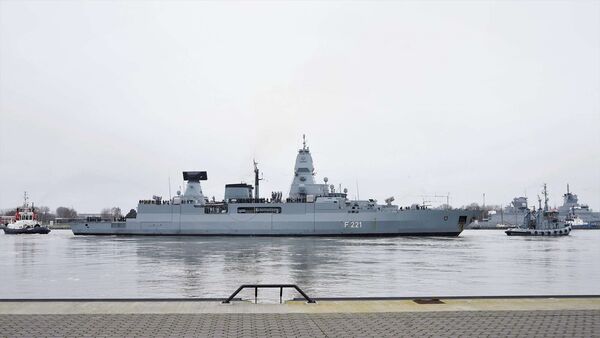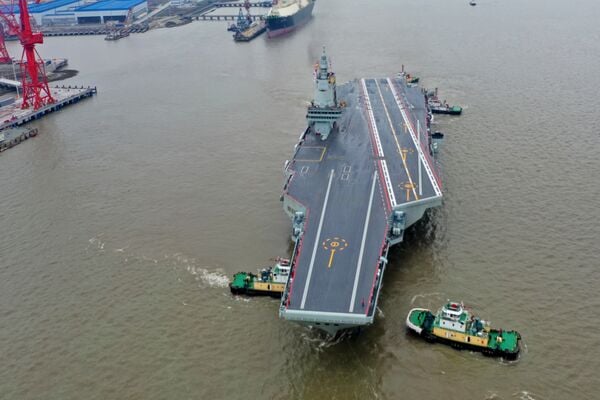- About
- Intara
- Capabilities
- Advisory
- Resources
- News
- Store
German frigate successfully intercepts Houthi attack UAVs in Red Sea
01 March 2024
by Kate Tringham & Alex Pape


Hessen is pictured departing Wilhelmshaven naval base on 8 February to join the EU's new maritime security mission to protect commercial shipping in the Red Sea. (Bundeswehr/Julia Kelm)
The German Navy's Type 124 Sachsen-class air-defence frigate FGS Hessen (F 221) successfully repelled two one-way attack unmanned aerial vehicles (UAVs) in the Red Sea launched by Yemen-based Ansar Allah (commonly known as the Houthis) militants on 27 February.
Briefing media at a German government press conference on 28 February, German Federal Ministry of Defence (MoD) spokesperson Michael Stempfle confirmed that the UAVs were launched in two separate attacks on the evening of 27 February.
The first UAV was detected by Hessen at 2000 h local time and was successfully intercepted shortly after using the ship's onboard 76 mm gun. The second UAV was detected 20 minutes later and was successfully engaged using the ship's RIM-116 Rolling Airframe Missile (RAM) short-range defence system, he said.
“They were detected by the radar system and were at different distances,” he said. “That's why there were two different weapons that were used.”
France orders first long-lead items for PA-NG carrier
03 May 2024
by Kate Tringham


An artist's impression of the French Navy's PA-NG next-generation carrier. (MO Porte Avions)
The French defence procurement agency (Direction Générale de l'Armement: DGA) has placed the first order for long-lead items for the country's future Porte-Avions Nouvelle Génération (PA-NG) next-generation nuclear-powered aircraft carrier (CVN), the French Ministry of the Armed Forces has confirmed.
In a 30 April announcement, the French defence ministry said the DGA had awarded a contract worth EUR600 million (USD642.7 million) to the PA-NG programme's industrial prime contractor MO Porte-Avions (a joint venture of Naval Group and Chantiers de l'Atlantique), and nuclear reactor developer TechnicAtome, covering the provision of long-lead elements related to the ship's nuclear propulsion, namely the K-22 nuclear reactors, their containment structures, and steam generation machinery.
The contract paves the way to start manufacturing these elements, with work expected to continue from 2024 to 2029 in advance of the start of construction of the aircraft carrier, the defence ministry said.
China's third aircraft carrier begins maiden sea trials
02 May 2024
by Ridzwan Rahmat


China's third aircraft carrier, seen here as it embarked on its maiden sea trials on 1 May 2024. (Pu Haiyang/VCG via Getty Images)
China's third aircraft carrier has embarked on its maiden sea trials, state-controlled Xinhua News Agency announced in its report on 1 May.
The carrier, Fujian , left the Jiangnan Shipyard in Shanghai at around 0800 h local time on the day of the announcement. These trials will primarily focus on testing the “reliability and stability of the aircraft carrier's propulsion and electrical systems”, reads the Xinhua report.
“Since its launch in June 2022, the Fujian has completed its mooring trials, outfitting work, and equipment adjustments. It has met the technical requirements for sea trials,” the report added.
Fujian was launched by Jiangnan Shipyard in June 2022. It is slated to be the People's Liberation Army Navy's (PLAN's) third aircraft carrier overall, but it is the service's first vessel to be configured for catapult-assisted take-off but arrested recovery (CATOBAR) aircraft operations.
New labour deal touted as possible pathway for national workforce model for naval ships
01 May 2024
by Michael Fabey


The US Navy has begun to improve its current public shipyards, such as the Portsmouth Naval Shipyard, shown here. (US Navy)
A new labour agreement signed on 29 April that seeks to build a rotational workforce of skilled welders could eventually serve as template for a national workforce arrangement for work on naval ships, according to Edward L Bartlett Jr, founder and CEO of Bartlett Maritime Corporation (BMC) – the company that brokered the deal.
The impetus for the rotational welders was a plan to use such a workforce to work on naval ships in Charleston, South Carolina, Bartlett told Janes in an interview on 29 April.
BMC hopes to prove out the concept through the recentlysigned labour deal and similar follow-on agreements. BMC has also proposed to construct and operate component repair facilities in northeast Ohio with an option to build a new public naval shipyard in Charleston.
The German Navy's Type 124 Sachsen-class air-defence frigate FGS Hessen (F 221) successfully repelle...
Latest Podcasts
Using OSINT to support law enforcement
Ritu Gill, Intelligence Analyst, joins Harry and Sean to discuss the practical use of OSINT to support law enforcement. Ritu discusses it’s use in supporting risk assessments and classified or closed sources of intelligence. She also discusses t...
Listen nowJanes Case Studies
Using Janes Intara to build a common intelligence picture: Russian build up on the Ukrainian border
View Case StudyNews Categories
 C4ISR Details
C4ISR Details